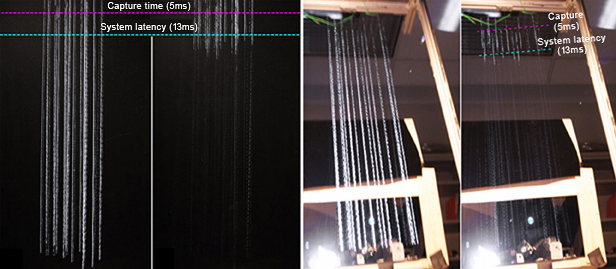Smart Headlights See through Rain and Snow

A prototype headlight system can detect raindrops or snow streaks and “dis-illuminate” them, thereby increasing visibility on the road ahead.
The system uses a digital projector to illuminate raindrops for several milliseconds while a camera mounted on the side of the projector captures each raindrop’s location; software predicts where those raindrops will fall within the driver’s field of view. Light rays from the headlight that would normally hit the raindrop are automatically switched off, reducing glare and leaving only the beams of light which travel uninterrupted in between the falling drops.
The system’s operating range is three to four meters in front of the projector—the “critical range” at which glare is most distracting, according to tests conducted using a Toyota Prius.
The system was developed by Carnegie Mellon computer science professor Srinivasa Narasimhan, along with several others. Narasimhan presented his findings in a talk at Microsoft Research and at Research@Intel 2012.
The researchers simulated different car speeds and rainfall intensity in the laboratory by varying the speed at which simulated rain streaks—using actual water propagated in front of the projector—shot past the screen. The system could reliably make rain streaks invisible at low speeds and still increase visibility at higher speeds by dimming some of the rain.
In severe thunderstorm rain, the accuracy is 70 percent at 30 kilometers per hour and 15 to 20 percent at 100 kilometers an hour; that’s how much of the rain is removed from view. Because water in a heavy rain is only 2 to 3 percent of the air volume, the rain can be filtered by dimming the headlights by just a few percent.
Substituting the hardware for a bigger and better camera would improve the system but increase its size and cost. However, making the system fast enough to reduce even more rain glare at highway speeds is important, because that’s where there’s greater risk for a catastrophic crash, says Narasimhan. He believes the experiments to date show that the idea is feasible, but notes that it will be necessary to account for the effects of car movement before the system can be used in the real world.
Kent Larson, who leads the CityCar project at MIT’s Media Lab, says the headlight system is another advance toward making vehicles more autonomous. “Eventually it won’t matter whether you have your vision obscured,” he says, because the car will be doing the driving on its own.
Keep Reading
Most Popular
Large language models can do jaw-dropping things. But nobody knows exactly why.
And that's a problem. Figuring it out is one of the biggest scientific puzzles of our time and a crucial step towards controlling more powerful future models.
How scientists traced a mysterious covid case back to six toilets
When wastewater surveillance turns into a hunt for a single infected individual, the ethics get tricky.
The problem with plug-in hybrids? Their drivers.
Plug-in hybrids are often sold as a transition to EVs, but new data from Europe shows we’re still underestimating the emissions they produce.
Stay connected
Get the latest updates from
MIT Technology Review
Discover special offers, top stories, upcoming events, and more.